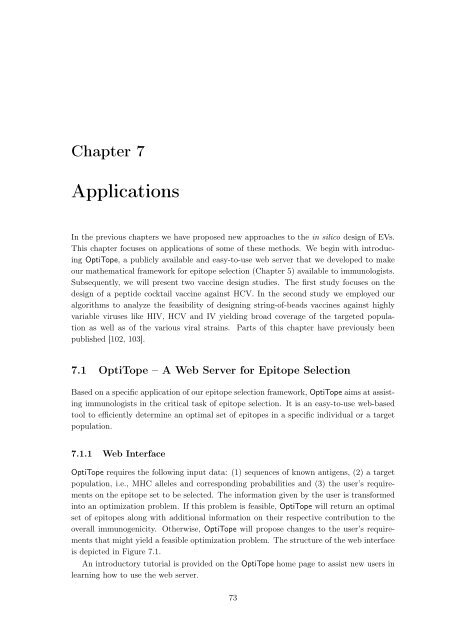New Approaches to in silico Design of Epitope-Based Vaccines
New Approaches to in silico Design of Epitope-Based Vaccines
New Approaches to in silico Design of Epitope-Based Vaccines
You also want an ePaper? Increase the reach of your titles
YUMPU automatically turns print PDFs into web optimized ePapers that Google loves.
Chapter 7<br />
Applications<br />
In the previous chapters we have proposed new approaches <strong>to</strong> the <strong>in</strong> <strong>silico</strong> design <strong>of</strong> EVs.<br />
This chapter focuses on applications <strong>of</strong> some <strong>of</strong> these methods. We beg<strong>in</strong> with <strong>in</strong>troduc<strong>in</strong>g<br />
OptiTope, a publicly available and easy-<strong>to</strong>-use web server that we developed <strong>to</strong> make<br />
our mathematical framework for epi<strong>to</strong>pe selection (Chapter 5) available <strong>to</strong> immunologists.<br />
Subsequently, we will present two vacc<strong>in</strong>e design studies. The first study focuses on the<br />
design <strong>of</strong> a peptide cocktail vacc<strong>in</strong>e aga<strong>in</strong>st HCV. In the second study we employed our<br />
algorithms <strong>to</strong> analyze the feasibility <strong>of</strong> design<strong>in</strong>g str<strong>in</strong>g-<strong>of</strong>-beads vacc<strong>in</strong>es aga<strong>in</strong>st highly<br />
variable viruses like HIV, HCV and IV yield<strong>in</strong>g broad coverage <strong>of</strong> the targeted population<br />
as well as <strong>of</strong> the various viral stra<strong>in</strong>s. Parts <strong>of</strong> this chapter have previously been<br />
published [102, 103].<br />
7.1 OptiTope – A Web Server for Epi<strong>to</strong>pe Selection<br />
<strong>Based</strong> on a specific application <strong>of</strong> our epi<strong>to</strong>pe selection framework, OptiTope aims at assist<strong>in</strong>g<br />
immunologists <strong>in</strong> the critical task <strong>of</strong> epi<strong>to</strong>pe selection. It is an easy-<strong>to</strong>-use web-based<br />
<strong>to</strong>ol <strong>to</strong> efficiently determ<strong>in</strong>e an optimal set <strong>of</strong> epi<strong>to</strong>pes <strong>in</strong> a specific <strong>in</strong>dividual or a target<br />
population.<br />
7.1.1 Web Interface<br />
OptiTope requires the follow<strong>in</strong>g <strong>in</strong>put data: (1) sequences <strong>of</strong> known antigens, (2) a target<br />
population, i.e., MHC alleles and correspond<strong>in</strong>g probabilities and (3) the user’s requirements<br />
on the epi<strong>to</strong>pe set <strong>to</strong> be selected. The <strong>in</strong>formation given by the user is transformed<br />
<strong>in</strong><strong>to</strong> an optimization problem. If this problem is feasible, OptiTope will return an optimal<br />
set <strong>of</strong> epi<strong>to</strong>pes along with additional <strong>in</strong>formation on their respective contribution <strong>to</strong> the<br />
overall immunogenicity. Otherwise, OptiTope will propose changes <strong>to</strong> the user’s requirements<br />
that might yield a feasible optimization problem. The structure <strong>of</strong> the web <strong>in</strong>terface<br />
is depicted <strong>in</strong> Figure 7.1.<br />
An <strong>in</strong>troduc<strong>to</strong>ry tu<strong>to</strong>rial is provided on the OptiTope home page <strong>to</strong> assist new users <strong>in</strong><br />
learn<strong>in</strong>g how <strong>to</strong> use the web server.<br />
73

















